A Traveler’s Guide to Potala Palace: Tips for an Unforgettable Visit
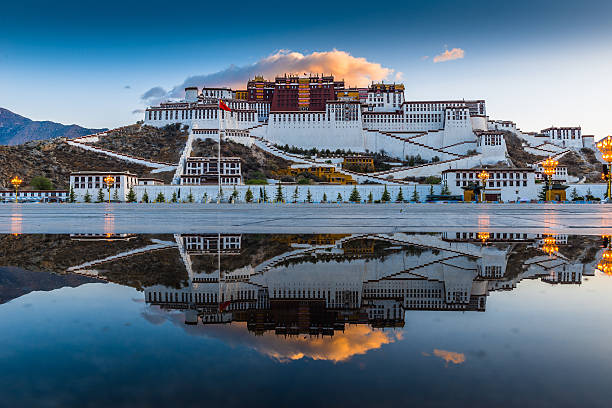
An Essential Guide to Visiting Potala Palace
Nestled high upon the majestic Marpo Ri (Red Mountain), the Potala Palace stands as a breathtaking symbol of Tibetan culture and spirituality. This architectural wonder, with its striking blend of Tibetan, Indian, and Nepalese styles, has captivated travelers for centuries, drawing those eager to explore its rich history and profound significance. As you approach this UNESCO World Heritage Site, the palace’s imposing silhouette against the vast Tibetan sky creates an immediate sense of awe, hinting at the treasures that lie within.
Originally constructed in the 7th century, the Potala Palace has served as a royal residence, a spiritual haven, and a political stronghold, evolving through the ages alongside the Tibetan people. Its 1,000+ rooms and intricate murals tell tales of devotion, resilience, and enlightenment. For pilgrims and tourists alike, a visit to the Potala Palace offers not just a glimpse into the past, but an opportunity to connect with the essence of Tibetan Buddhism and the unwavering spirit of its people.
In this guide, you will find essential tips and insights to enrich your experience as you embark on this unforgettable journey. Whether you’re drawn by the allure of its storied halls, the serenity of its sacred spaces, or the breathtaking views from its golden roofs, the Potala Palace promises an adventure that transcends the ordinary and invites you to explore the heart of Tibet’s heritage. Prepare to be enchanted as you step into a world where history, culture, and spirituality converge.
In This Guide
- An Essential Guide to Visiting Potala Palace
- The Rich History and Legends of Potala Palace
- Main Highlights: What You Absolutely Can’t Miss
- Planning Your Visit: A Practical Guide
- Tickets: Prices, Booking, and Tips
- How to Get There: A Complete Transportation Guide
- Local Cuisine and Accommodation Nearby
- Frequently Asked Questions
- Final Thoughts on Your Trip
The Rich History and Legends of Potala Palace
Nestled atop the towering Marpo Ri (Red Mountain) in Lhasa, Tibet, the Potala Palace stands as a symbol of both spiritual and political power, embodying centuries of rich history and profound legends. Its origins can be traced back to the 7th century, when the visionary King Songtsen Gampo commissioned its initial construction. This modest fortress was intended to house sacred Buddhist relics, marking the early integration of Buddhism into Tibetan culture. King Songtsen Gampo, an integral figure in Tibetan history, is also credited with uniting various tribes and establishing a centralized government, laying the groundwork for Tibet’s future.
The palace’s evolution took a monumental turn during the reign of the 5th Dalai Lama in the 17th century. Under his guidance, the Potala Palace transformed from a simple stronghold into a magnificent architectural marvel, blending Tibetan, Indian, and Nepalese influences. This period marked the palace’s rise as the spiritual, administrative, and cultural heart of Tibet, a role it has maintained for centuries. The 5th Dalai Lama’s vision encompassed not only governance but also the cultivation of a rich spiritual life, making the Potala Palace a hub for religious practices and political discourse.
Throughout its history, the Potala Palace has witnessed the ebb and flow of Tibetan Buddhism, serving as a residence for the Dalai Lamas and a center for Tibetan culture. Each Dalai Lama has left an indelible mark on the palace, contributing to its extensive collection of sacred artifacts and artworks, which narrate the spiritual journey of the Tibetan people. The Red Palace, in particular, is a testament to this legacy, housing the tombs of past Dalai Lamas and adorned with intricate murals that depict the teachings of Buddhism and the legends of Tibetan history.
As a UNESCO World Heritage Site, the Potala Palace is not just an architectural wonder; it is a repository of stories and legends. The tales of the Dalai Lamas, their spiritual journeys, and their interactions with the world beyond Tibet are woven into the very fabric of this historic edifice. Visitors can almost feel the whispers of history echoing through its halls, from the solemnity of the chapels to the grandeur of the audience rooms where crucial decisions were made.
In the following centuries, the Potala Palace has served as a bastion of Tibetan culture and identity, enduring challenges and changes while remaining a beacon of hope and spiritual refuge for many. It stands resilient against the backdrop of the Himalayan landscape, a reminder of the Tibetan people’s unwavering devotion to their faith and heritage.
Today, the Potala Palace continues to captivate travelers and pilgrims alike, inviting them to explore its storied halls and absorb the profound energy that resonates within its walls. Each visit to this iconic landmark is not only a journey through time but also an immersion into the rich tapestry of Tibetan history and spirituality. Whether you are drawn by the allure of its stunning architecture or the depth of its cultural significance, the Potala Palace promises an unforgettable experience steeped in the legends of a land that has captured hearts for centuries.

Potala Palace.
Main Highlights: What You Absolutely Can’t Miss
The Potala Palace is a breathtaking testament to Tibetan culture and history, and exploring its majestic halls is an experience that no traveler should miss. Here are the main highlights that you absolutely cannot overlook during your visit:
The White Palace
1. Administrative and Residential Heart
The White Palace is not just an architectural wonder; it serves as the administrative hub and former residence of the Dalai Lamas. As you wander through its halls, be sure to visit:
– Audience Halls: Where significant gatherings and ceremonies were held, showcasing the political history of Tibet.
– Living Quarters: Filled with artifacts and relics that offer a glimpse into the daily lives of the Dalai Lamas.
– The Golden Roof: Ascend to this vantage point for panoramic views of Lhasa, where the city unfurls beneath you against the backdrop of the Himalayas.
2. Pilgrimage Halls and Sutra Rooms
Discover the intricacies of Tibetan Buddhism in the pilgrimage and sutra halls, where monks have meditated for centuries. The luxurious furnishings and sacred atmosphere invite reflection and reverence.
The Red Palace
1. Spiritual Epicenter
The Red Palace is the spiritual heart of the Potala, filled with chapels, shrines, and the tombs of previous Dalai Lamas. Highlights include:
– Hall of the Dharma King: A significant site housing relics and representations of Tibetan rulers, echoing the power and influence of the Lamas.
– Hall of Saints: Home to sacred statues, including a revered Ganesha statue, this hall is a vital part of the spiritual tapestry of the palace.
2. Stupas and Murals
Marvel at the stunning stupas adorned with gold and jewels, which symbolize the spiritual lineage of Tibetan Buddhism. The walls are covered in intricate murals that depict the life of the Buddha and important historical figures, offering insights into the rich narrative of Tibetan culture.
Sacred Artifacts and Murals
As you explore the corridors of the palace, take the time to appreciate the countless murals and religious artifacts. These masterpieces provide a deeper understanding of Tibetan mythology, history, and spiritual practices. The vibrant colors and detailed artistry will surely captivate your imagination and spirit.
Architectural Brilliance
The Potala Palace’s architectural design is a marvel in itself. Spanning 13 stories and featuring over 1,000 rooms, it is a masterclass in engineering, blending Tibetan, Indian, and Nepalese styles. The harmonious interplay between stone, timber, and rammed earth reflects the resilience of Tibetan culture against the harsh Himalayan climate.
Deyang Shar
Don’t miss the Deyang Shar, a wide square that offers a unique perspective of the palace. This space served as a gathering place for watching dramas and conducting public activities, providing a lively contrast to the palace’s serene interiors.
Practical Insights
While exploring these highlights, remember that a guided tour can enhance your experience. Knowledgeable guides will share the rich history and significance behind each site, ensuring you leave with a profound understanding of this iconic landmark.
Conclusion
The Potala Palace is not merely a destination; it is a journey into the heart of Tibetan spirituality and culture. From the administrative halls of the White Palace to the sacred spaces of the Red Palace, every corner invites exploration and contemplation. Make sure to take your time to absorb the beauty and history that this UNESCO World Heritage Site offers.
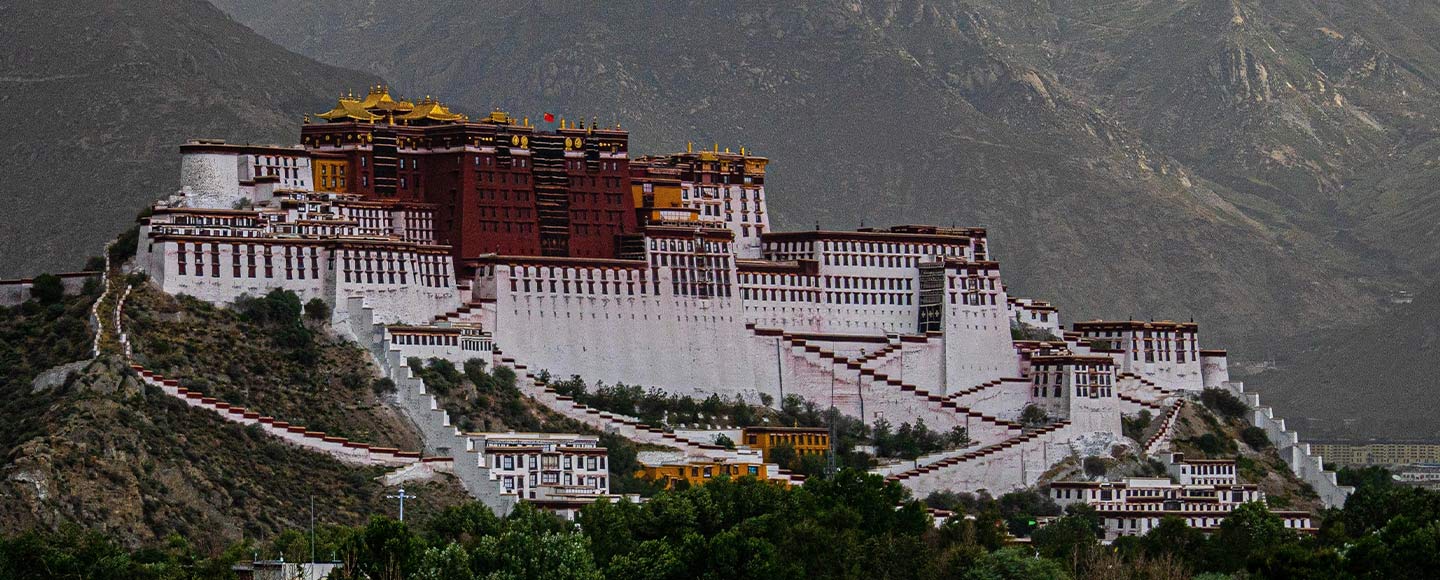
Potala Palace.
Planning Your Visit: A Practical Guide
Visiting the Potala Palace is a journey that transcends mere sightseeing; it’s an exploration of Tibetan history, spirituality, and culture. Here’s everything you need to know to plan an unforgettable visit.
Getting There
The Potala Palace is located in Lhasa, the capital of Tibet, situated at an altitude of approximately 3,700 meters (12,139 feet). Most international travelers will arrive via Lhasa Gonggar Airport, which connects with major cities in China. From the airport, you can take a taxi or arrange a transfer through a travel agency. It’s advisable to acclimatize before exploring the high-altitude surroundings.
Booking Your Visit
- Tickets: Due to the limited number of daily visitors, it’s crucial to book your tickets in advance. You can purchase them online or through a local travel agency.
- Time Slots: Each ticket grants access for a specific one-hour time slot, so punctuality is key. Arrive at least 30 minutes prior to your scheduled entry.
- Guided Tours: To enrich your experience, consider joining a guided tour. Expert guides can provide valuable insights into the palace’s history, architecture, and cultural significance.
Dress Code
Respect for local customs is paramount when visiting the Potala Palace.
- Clothing: Dress modestly; avoid shorts, sleeveless tops, and revealing outfits. Comfortable shoes are recommended for the extensive walking involved.
- Inside the Palace: Remove sunglasses and hats when entering sacred spaces to show respect for Tibetan culture.
Photography Policies
- Inside the Palace: Photography is prohibited within the palace to protect its sacred interiors and artifacts.
- Outside the Palace: Feel free to capture the stunning exterior views against the dramatic Himalayan backdrop.
Altitude Awareness
Acclimatization is essential when traveling to high-altitude locations like Lhasa.
- Hydration: Drink plenty of water to stay hydrated.
- Rest: Take it easy on your first day; avoid strenuous activities to help your body adjust.
- Health Consultation: If you have any health concerns, consult a healthcare professional before your trip.
Best Times to Visit
- Spring (March to May): Experience pleasant weather with blooming landscapes, making it ideal for exploration.
- Autumn (September to November): Enjoy clear skies and breathtaking views of the surrounding mountains.
- Winter (December to February): It’s best to avoid winter due to extreme cold and limited accessibility.
Nearby Attractions
Your visit to the Potala Palace can be enhanced by exploring other significant sites in Lhasa:
- Jokhang Temple: Considered the holiest temple in Tibetan Buddhism, it’s a short distance from the Potala Palace.
- Norbulingka Palace: The summer residence of the Dalai Lamas, filled with beautiful gardens and historical significance.
- Barkhor Street: A vibrant market area offering a taste of local culture and a chance to pick up unique souvenirs.
Enhancing Your Experience
To delve deeper into the rich history and culture of Tibet, consider booking a comprehensive tour package through a reputable travel agency like Best Heritage Tour. Their experienced guides can provide context and access to hidden gems, making your visit to the Potala Palace and other landmarks truly memorable.
Final Thoughts
The Potala Palace stands not only as a symbol of Tibetan culture and spirituality but also as a breathtaking architectural wonder. Preparing for your visit with these practical tips will ensure that you fully appreciate the depth of this extraordinary site. Embrace the experience, and let the grandeur of the Potala Palace captivate your spirit.
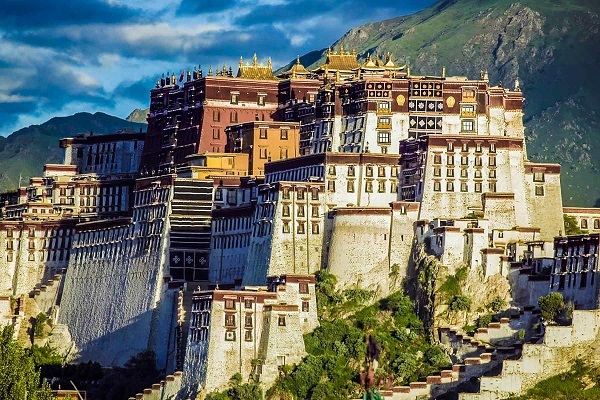
Potala Palace.
Tickets: Prices, Booking, and Tips
When planning your visit to the awe-inspiring Potala Palace, it’s essential to be well-informed about ticket prices, booking procedures, and useful tips to ensure a smooth experience.
Ticket Prices
Admission to the Potala Palace is reasonably priced, with tickets typically costing around ¥200 (approximately $30 USD) for international tourists. This fee includes access to both the White and Red Palaces, where you can immerse yourself in the rich history and spiritual significance of this iconic site.
Booking Your Tickets
Due to the popularity of the Potala Palace, it is highly recommended that you book your tickets in advance. Daily visitor numbers are limited to preserve the integrity of the site, and securing your spot ahead of time will save you from potential disappointment. Here’s how you can book:
- Online Reservations: Tickets can often be purchased through official tourism websites or authorized travel agencies. Make sure to confirm the legitimacy of the site before making a payment.
- On-Site Purchase: If you prefer last-minute plans, you can also buy tickets directly at the palace entrance, but be prepared for long queues, especially during peak tourist seasons.
Punctuality Matters
Each ticket grants you a specific one-hour time slot for entry, so it’s crucial to arrive on time. Be mindful of the local time and plan to arrive a bit earlier to account for any unforeseen delays.
Guided Tours
To truly appreciate the Potala Palace’s historical and spiritual significance, consider joining a guided tour. Knowledgeable guides can provide context and insights that enhance your understanding of the art, architecture, and culture represented within the palace. Group tours often include skip-the-line access, making them a convenient option.
Practical Tips
- Dress Code: Wear modest clothing, as the Potala Palace is a sacred site. Avoid shorts and sleeveless tops. Hats and sunglasses should be removed once inside.
- Photography: While photography is prohibited within the palace to protect its sacred artifacts, you can capture stunning exterior views of the palace against the majestic Tibetan landscape.
- Altitude Awareness: Lhasa sits at an elevation of approximately 3,700 meters (12,139 feet). Ensure you take time to acclimatize, stay hydrated, and avoid strenuous activities during your initial days in the city.
By keeping these ticketing tips in mind and planning your visit thoughtfully, you can fully enjoy the breathtaking experience of exploring the Potala Palace, a true gem in the heart of Tibet.
How to Get There: A Complete Transportation Guide
Reaching the majestic Potala Palace, a pinnacle of Tibetan culture and spirituality, is an adventure that begins long before you set foot within its iconic walls. Here’s a comprehensive guide to navigating your way to this UNESCO World Heritage Site, ensuring a seamless journey to one of the most revered landmarks in Tibet.
Getting to Lhasa
By Air:
The quickest way to arrive in Lhasa is by flying into Lhasa Gonggar Airport (LXA). This airport is well-connected with major cities in China, such as Beijing, Chengdu, and Xi’an. Upon landing, travelers will enjoy breathtaking views of the Tibetan Plateau. It’s crucial to note that flights may be affected by weather conditions, so it’s advisable to check the status ahead of time.
By Train:
For those seeking a more scenic approach, the train journey to Lhasa is an experience in itself. The Qinghai-Tibet Railway, which is the highest railway line in the world, connects Lhasa with several cities in mainland China. Trains depart from cities like Xining, Chengdu, and Beijing. The gradual ascent allows travelers to acclimatize to the altitude, making it a preferred option for many.
By Road:
If you’re adventurous and have the time, consider traveling by road. Various overland routes connect Lhasa to neighboring regions, including Nepal and mainland China. However, this option requires careful planning, including securing the necessary permits and hiring a qualified driver familiar with the terrain.
Reaching Potala Palace from Lhasa City Center
Once you have arrived in Lhasa, getting to the Potala Palace is relatively straightforward.
Walking:
The Potala Palace is located in the heart of Lhasa, making it easily accessible on foot for visitors staying nearby. The walk offers a chance to soak in the local culture and atmosphere, with shops, eateries, and stunning views along the way. Depending on your starting point, expect a leisurely stroll of around 15 to 30 minutes.
By Taxi or Ride-Sharing:
If you prefer a quicker option, taxis are widely available throughout Lhasa. A short ride to the Potala Palace will typically cost between 10 to 30 Chinese Yuan, depending on your starting location. Ride-sharing apps are also operational in the city, providing another convenient alternative.
Public Bus:
For budget-conscious travelers, Lhasa’s public bus system includes routes that service the Potala Palace. Look for buses that specifically list the Potala Palace as one of their stops. This option is both economical and gives you a glimpse into the daily life of local residents.
Considerations for Altitude
Lhasa is situated at an altitude of approximately 3,650 meters (12,000 feet). For many international travelers, this can pose challenges. Here are some tips to help you acclimatize:
- Take it Slow: Allow yourself a few days in Lhasa to adjust to the altitude before embarking on strenuous activities.
- Stay Hydrated: Drink plenty of water to help your body acclimatize and prevent altitude sickness.
- Avoid Alcohol and Heavy Meals: In the initial days, it’s wise to refrain from alcohol and heavy meals, as they can exacerbate altitude sickness symptoms.
Final Tips
- Permits: Ensure you have the necessary permits to enter Tibet. These are typically arranged through a travel agency.
- Guided Tours: Although it’s possible to explore the area independently, joining a guided tour will enrich your experience with insights into the rich history and culture of the Potala Palace.
- Best Time to Visit: The ideal months to visit are between March and May or September and November when the weather is mild and the skies are clear.
By carefully planning your travel to Lhasa and the Potala Palace, you can focus on what truly matters: immersing yourself in the unique and spiritual atmosphere of this remarkable site. Enjoy your journey to the heart of Tibetan culture!
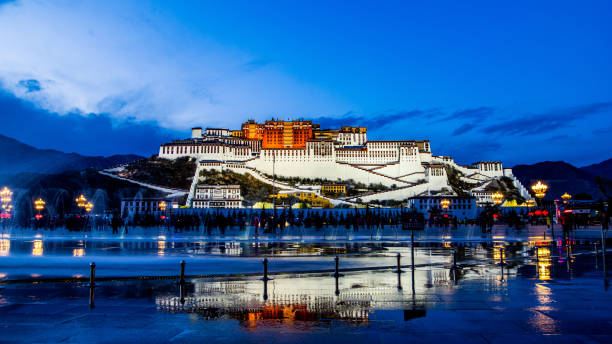
Potala Palace.
Local Cuisine and Accommodation Nearby
When exploring the majestic Potala Palace, taste the rich flavors of Tibetan cuisine and find comfortable accommodations that enhance your cultural experience. Nestled in the heart of Lhasa, you’ll discover a variety of dining options and cozy places to stay, allowing you to immerse yourself in the local culture while enjoying your visit.
Culinary Delights
1. Tibetan Family Kitchen
Located just a short walk from the Potala Palace, this charming restaurant offers an authentic taste of Tibetan home cooking. Dine in a warm and welcoming atmosphere while savoring traditional dishes like momos (steamed dumplings), thukpa (noodle soup), and yak butter tea. The owners take great pride in using fresh, local ingredients, making each meal a delightful experience.
2. Snowland Restaurant
A popular choice among tourists, Snowland Restaurant is known for its extensive menu that combines Tibetan and Chinese cuisine. Indulge in their signature Tibetan-style fried rice, or try the Lhasa-style yak steak for a hearty meal. The restaurant’s decor, adorned with Tibetan art, adds to the overall experience.
3. Dunya Restaurant
If you’re in the mood for something different, Dunya offers a fusion of Middle Eastern and Tibetan flavors. Their falafel and hummus are highly recommended, but don’t miss out on the chance to try their Tibetan pizza, which is a unique twist that marries local ingredients with international favorites.
4. Yak Restaurant
This eatery provides a blend of traditional Tibetan and Western cuisine. Located close to the Barkhor Street, it’s a great place to unwind after a day of exploration. The yak burgers and vegetarian curry are crowd favorites, and the vibrant atmosphere makes it an enjoyable spot for an evening meal.
Places to Stay
1. St. Regis Lhasa Resort
For a luxurious stay, the St. Regis Lhasa Resort offers breathtaking views of the Potala Palace and the surrounding mountains. With opulent rooms, world-class amenities, and a spa, it’s the perfect place to relax after a day of sightseeing. The hotel’s restaurant features a mix of Tibetan and international cuisine, ensuring a delightful dining experience.
2. Yak Hotel
This mid-range option provides comfortable accommodations with Tibetan-style decor. Located just minutes from the Potala Palace, Yak Hotel is a great base for your explorations. The on-site restaurant serves hearty Tibetan dishes, and the staff is known for their warm hospitality.
3. House of Shambhala
For travelers seeking a more intimate experience, the House of Shambhala offers a boutique hotel atmosphere with beautifully designed rooms that reflect Tibetan culture. Its proximity to the Barkhor area allows easy access to local markets and eateries. Enjoy breakfast with a view of the Potala Palace to start your day on a high note.
4. Lhasa Tsangba Hotel
This budget-friendly hotel is ideal for backpackers and those looking for simple, clean accommodations. With its central location, you’ll be within walking distance of many attractions, including the Potala Palace. The hotel’s restaurant serves affordable and delicious Tibetan meals, making it a convenient option for travelers.
As you plan your visit to the Potala Palace, make sure to indulge in the local culinary scene and find accommodations that suit your travel style. Whether you prefer luxury or a cozy guesthouse, Lhasa has something for everyone, ensuring your journey is both comfortable and memorable.
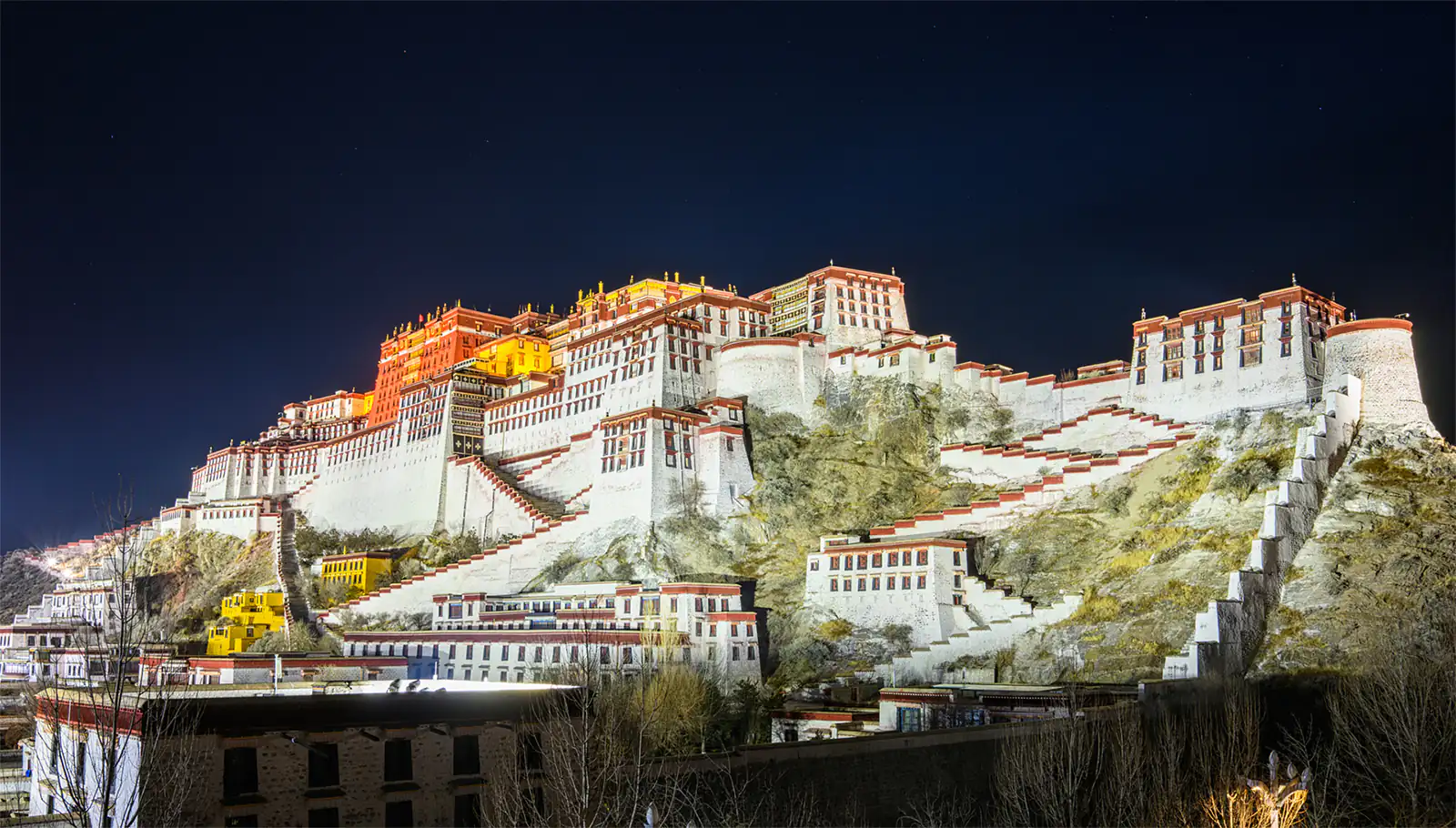
Potala Palace.
Frequently Asked Questions
Frequently Asked Questions about Potala Palace
-
What are the opening hours of Potala Palace?
Potala Palace typically opens from 9 AM to 5 PM, but visiting hours may vary depending on the season. It’s best to check the official website or contact your tour provider for the most accurate information before your visit. -
How do I book tickets for Potala Palace?
Tickets can be booked online or in person, but it’s highly recommended to reserve in advance due to daily visitor limits. Each ticket allows a one-hour slot for exploration, so punctuality is essential. -
Is a guided tour necessary for visiting Potala Palace?
While it’s possible to explore on your own, a guided tour is highly recommended. Knowledgeable guides can provide valuable historical context and insights into the significance of various artifacts and architectural features, enriching your experience. -
What should I wear when visiting Potala Palace?
Dress modestly to show respect for the cultural and religious significance of the site. Avoid shorts, sleeveless tops, and revealing clothing. Comfortable shoes are also advisable, as you will be climbing many steps. -
Can I take photographs inside Potala Palace?
Photography is not permitted inside the palace to protect its sacred interiors. However, feel free to capture stunning exterior shots of the palace against the backdrop of Lhasa. -
What should I know about altitude sickness before visiting?
Lhasa is located at approximately 3,650 meters (12,000 feet) above sea level. To avoid altitude sickness, allow time for acclimatization, stay hydrated, and avoid strenuous activities, especially on your first day. -
What are some nearby attractions I shouldn’t miss?
While in Lhasa, consider visiting the Jokhang Temple, Norbulingka Palace, and the bustling Barkhor Street for a complete cultural experience. Each site offers unique insights into Tibetan history and spirituality. -
When is the best time to visit Potala Palace?
The ideal times to visit are during spring (March to May) and autumn (September to November) when the weather is pleasant and the skies are clear. Avoid winter months due to extreme cold and potential accessibility issues.
Final Thoughts on Your Trip
As your journey to the Potala Palace comes to a close, take a moment to reflect on the profound experience you’ve just encountered. Standing before this iconic symbol of Tibetan culture, you’ve not only marveled at its breathtaking architecture but also immersed yourself in the rich tapestry of history, spirituality, and resilience that defines Tibet. Each step you took within its grand halls echoed the whispers of centuries past, where the stories of Dalai Lamas and devoted pilgrims intertwine in a narrative of devotion and hope.
The serene ambiance and stunning vistas surrounding the palace offer a sense of tranquility that lingers long after you leave. Whether you were captivated by the intricate murals, awed by the golden roofs, or inspired by the spiritual significance of the Red Palace, your visit to the Potala Palace is sure to resonate within you.
As you depart, remember that this magnificent site is more than just a destination; it is a living testament to the enduring spirit of the Tibetan people and their unwavering faith. Take the memories of this extraordinary place with you, share them with others, and carry a piece of Tibetan heritage in your heart wherever your travels may lead you next. Safe travels, and may your adventures continue to inspire and enlighten!